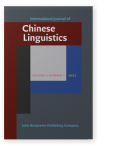Vol. 9:1 (2022) ► pp.49–77
Two kinds of selection marking
Why does an argument clause contain a meaningless complementizer in languages such as English and German, but not in Mandarin; and why does an adverbial clause occur with a meaningless correlative adverb in the matrix clause in Mandarin, but not in languages such as English and German? Extending the c-selection from one type of sisterhood to another type of sisterhood, this paper recognizes the modification relation as a kind of selection relation, in addition to the familiar kind of argument-taking selection relation. This research argues that dependency marking is seen in different types of sister relations. It shows how Mandarin uses modification markers systematically, but does not use argument markers, also systematically. The paper explains the existence of modification markers in various constructions in Mandarin and in various languages. It lets us gain a better understanding of language variations.
Article outline
- 1.Two empirical issues
- 2.From Bruening’s (2010) selection theory to the selection marking patterns
- 2.1Two kinds of selection and selection markers
- 2.2General properties of SMs
- 3.Syntagmatic properties of SMs in adverbial clause constructions
- 3.1The base-position of an adverbial clause
- 3.2The position of an SM
- 3.3The SMs in paired-conjunction constructions
- 3.4The absence of an SM in relevance adverbial constructions
- 4.SMs and various types of apparent sentence-final adverbial clauses
- 4.1Sentence-final embedded clauses that are complement clauses
- 4.2Sentence-final embedded clauses that are stranded by movement
- 4.3Sentence-final embedded clauses that are not modifiers of the preceding clauses
- 5.SMs and some other modification constructions in Mandarin and beyond
- 5.1The modification marker de as an SM in Mandarin
- 5.2Modification markers in other languages
- 6.Conclusions
- Acknowledgements
- Notes
-
References
For any use beyond this license, please contact the publisher at [email protected].
